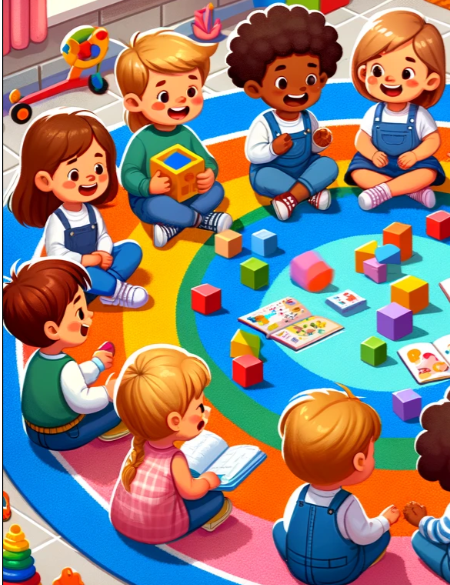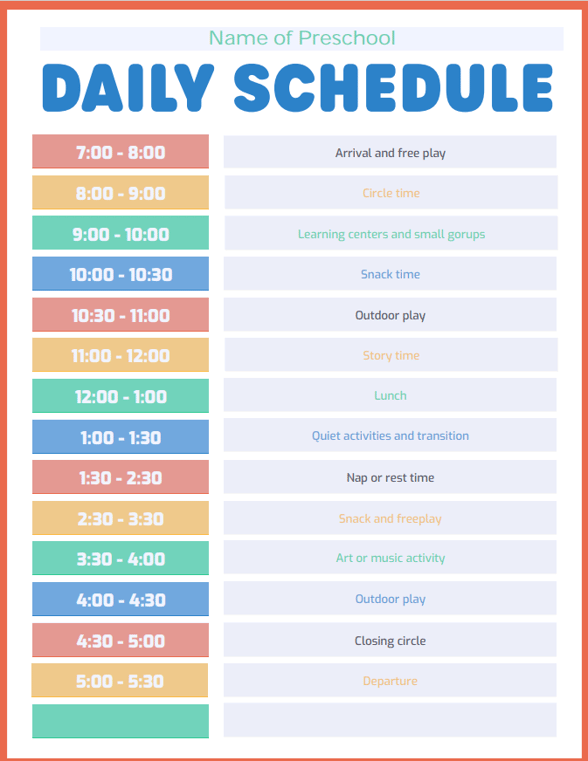Your daily schedule holds the key to transforming your classroom and maximizing student success. Discover the essential elements of a powerful routine, proven strategies for engaging different age groups and the secret weapon of visual schedules in this must-read article. Plus, get instant access to sample activities, customizable templates and expert tips for optimizing your schedule. Don't miss this opportunity to amp up your teaching approach and ensure every day runs smoothly.
Table of Contents
- Understanding the Importance of a Preschool Daily Schedule
- Creating a Balanced Daily Schedule for Preschoolers
- The Role of Visual Schedules in Preschool Classrooms
- Managing Transitions and Group Activities Effectively
- Customizing Your Preschool Daily Schedule for Maximum Engagement
- Get 70+ Editable and Printable Templates for Almost Every Preschool Situation
Understanding the Importance of a Preschool Daily Schedule

What Is a Daily Schedule in Preschool?
A daily schedule in the context of preschool refers to a structured plan that outlines the activities and routines followed by young children throughout the day. It provides a predictable framework that supports their learning, development and overall well-being (ECLKC). A typical preschool daily schedule includes a variety of activities designed to promote cognitive, physical, social and emotional growth.
Examples of typical activities included in a preschool schedule are:
- Circle time for group discussions and introductions
- Learning centers for hands-on exploration and play
- Outdoor play for gross motor activities and development
- Story time for language and literacy development
- Art activities for creativity and fine motor skills
- Snack time for nutrition and socialization
- Rest or nap time for relaxation and rejuvenation
How Does a Daily Schedule Benefit Preschoolers' Development?
A well-structured daily schedule provides numerous benefits for preschoolers' development across various areas. Here are some key advantages:
- Emotional stability: Research tells us that a consistent daily routine helps children feel secure, knowing what to expect and reducing anxiety (The Goddard School).
- Sense of control: Following schedules and routines gives children a sense of autonomy and control over their environment.
- Transitions and time management: By following a schedule, children learn to manage transitions between activities and develop an understanding of time concepts.
- Social skills: Children need group activities and routines to foster social interactions, cooperation and turn-taking among peers (PBS).
- Cognitive development: A structured learning environment supports cognitive development through engaging activities, problem-solving and critical thinking.
- Physical development: Daily schedules often include outdoor and/or playground play and movement activities, promoting gross and fine motor skills development.
- Language and literacy: Activities like story time and circle time enhance language development, vocabulary and pre-reading skills.
- Self-help skills: Routines such as snack time and cleanup time routines encourage independence and self-help skills.
- Behavior management: A consistent schedule helps establish behavioral expectations and routines, reducing problem behaviors.
What Elements Should a Preschool Daily Schedule Include?
A well-rounded preschool daily schedule should include the following key components:
-
Circle time: This is a group gathering where children engage in large group activities like singing songs, telling stories and discussions. It promotes social interaction, listening skills and attention span development.
-
Learning centers: These are designated areas where children can explore different materials and engage in hands-on activities. Early childhood learning centers can include areas for art, sensory play, science, math, language and dramatic play. They encourage independent exploration and foster various skills.
-
Outdoor play: Outdoor playtime allows children to engage in physical activities, develop gross motor skills and experience nature. It provides opportunities for movement, social interaction and exploration of the environment.
-
Snack time: Incorporating designated snack times promotes healthy eating habits, socialization and self-help skills. It's also an opportunity for children to practice table manners, sharing and trying new foods.
-
Rest or nap time: Providing a designated rest or nap time allows children to recharge and promotes their overall well-being. It supports physical and cognitive development by ensuring adequate rest.
-
Structured learning activities: These activities can include teacher-directed lessons, group projects and targeted skill-building exercises. They provide focused learning experiences and help prepare children for kindergarten readiness.
-
Free play: Allowing time for unstructured play is essential for fostering creativity, imagination and problem-solving skills. It encourages children to explore their interests and develop social and emotional competence.
-
Transitions: Smooth transitions between activities are important for maintaining a sense of order and minimizing disruptions. Including transition periods in the schedule helps children adjust from one activity to another more easily.
Creating a Balanced Daily Schedule for Preschoolers

Sample Activities for a Preschool Daily Schedule
When creating a preschool daily schedule, it's important to include a variety of activities that cater to different learning styles and interests, but still work with your classroom's daily rhythm. Here are some examples of activities that can be incorporated into a balanced schedule:
| Activity Type | Examples |
|---|---|
| Cognitive | Puzzles, matching games, sorting activities, science experiments |
| Physical | Outdoor play, obstacle courses, dancing, yoga |
| Creative | Art projects, dramatic play, music and movement |
| Language and Literacy | Story time, puppet shows, letter and sound activities |
| Social and Emotional | Cooperative games, role-playing, sharing and turn-taking activities |
Sample Schedules
Half-Day Preschool Schedule
| Time | Activity |
|---|---|
| 8:00-8:30 a.m. | Arrival and free play |
| 8:30-9:00 a.m. | Circle time |
| 9:00-9:30 a.m. | Small group activities |
| 9:30-10:00 a.m. | Snack time |
| 10:00-10:30 a.m. | Outdoor play |
| 10:30-11:00 a.m. | Art or music activity |
| 11:00-11:30 a.m. | Story time and closing circle |
| 11:30 a.m.-12:00 p.m. | Departure and free play |
Full-Day Preschool Schedule
| Time | Activity |
|---|---|
| 7:30-8:30 a.m. | Drop-off and free play |
| 8:30-9:00 a.m. | Circle time |
| 9:00-10:00 a.m. | Learning centers and small groups |
| 10:00-10:30 a.m. | Snack time |
| 10:30-11:15 a.m. | Outdoor play |
| 11:15-11:45 a.m. | Story time |
| 11:45 a.m. -12:30 p.m. | Lunch |
| 12:30-1:00 p.m. | Quiet activities and transition |
| 1:00-2:30 p.m. | Nap or rest time |
| 2:30-3:00 p.m. | Snack and free play |
| 3:00-3:30 p.m. | Art or music activity |
| 3:30-4:00 p.m. | Outdoor play |
| 4:00-4:30 p.m. | Closing circle and departure |
Free Preschool Daily Schedule Templates
Creating a visually appealing daily preschool schedule is no simple feat. Because Vanco is always looking to save preschools time, whether it's with our preschool management software or our free templates to cut down on busywork, we've built a series of free preschool daily schedule templates you can use to simplify your work.
If you're looking for even more daily schedule templates to use, check out Canva's daily schedule templates here.
Importance of Including Nap and Snack Times in the Schedule
Nap and snack times are crucial components of a preschool daily schedule, as they directly impact a child's well-being and ability to learn. Adequate rest and nutrition are essential for supporting physical growth, cognitive development and emotional regulation.
The Centers for Disease Control and Prevention (CDC) recommends that preschool-aged children get 10-13 hours of sleep per day, including naps (CDC). Incorporating a designated nap or rest time every day as part of your daily schedule ensures that children have the opportunity to recharge and process the information they have learned throughout the day.
Similarly, regular snack times provide children with the necessary energy to stay focused and engaged in learning activities. The American Academy of Pediatrics suggests that preschoolers need a balanced diet with a variety of nutrient-dense foods to support their growth and development (AAP). Integrating snack times into the daily schedule will help educators promote healthy eating habits and ensure that children have the sustenance they need to thrive.
The Role of Visual Schedules in Preschool Classrooms

How Visual Cues Help Children Navigate Daily Routines
Visual schedules are powerful tools that support young children's understanding of time and routine. By using pictures, symbols or photographs to represent daily activities, you can post a visual schedule that provides a concrete representation of the day's events. This visual format helps children comprehend the sequence of activities and anticipate transitions, reducing anxiety and promoting a sense of security (Buckeye Union School District).
Integrating visual cues into the daily schedule can enhance learning in several ways by:
- Providing structure and predictability
- Encouraging independence and self-regulation
- Supporting language development
- Facilitating transitions between activities
Implementing Visual Schedules for Play and Learning Activities
When creating and using visual schedules for various activities throughout the day, consider the following tips and components of an effective schedule:
- Use clear, simple images that are easily recognizable to children.
- Arrange the schedule in a logical, sequential order so children know what to expect each day.
- Place the schedule at children's eye level for easy reference.
- Use a consistent format and location for the visual schedule.
- Involve children in creating and updating the schedule together, promoting ownership and engagement.
- Refer to the schedule regularly throughout the day, highlighting completed activities and upcoming events during each part of the day.
- Incorporate visual cues for specific steps within activities (e.g., handwashing sequence).
- Adapt the schedule as needed to accommodate changes in routine or special events.
Enhancing Literacy Skills Through Visual Schedule Integration
Visual schedules work as tools to bolster early literacy skills in preschool classrooms. By incorporating written words alongside pictures, educators can help children make connections between visual and written representations of language.
Some ways to enhance literacy skills through visual schedule integration include:
- Labeling pictures with corresponding words to promote print awareness
- Encouraging children to "read" the schedule by describing the images and activities
- Incorporating story-related visual cues into the schedule (e.g., pictures from a book read during story time)
- Using the schedule as a reference for children to dictate or write their own daily routines
Managing Transitions and Group Activities Effectively
Strategies for Transition Times in a Preschool Day
Transition times, such as moving from one activity to another or cleaning up after play, can be challenging for young children. To help smoothly navigate these moments and reduce stress, consider the following strategies:
| Transition | Challenges | Strategies |
|---|---|---|
| Cleanup time | Children may resist cleaning up or become distracted | Use a consistent signal (e.g., a song or chime) children understand to indicate cleanup time; make cleanup a game or challenge; provide specific tasks for each child |
| Moving between activities | Children may have difficulty ending an activity or starting a new one | Give advance warning before transitions; use visual supports to indicate the next activity; provide clear instructions and expectations |
| Waiting for a turn | Children may become impatient or frustrated when waiting | Offer engaging activities or materials for children to use while waiting; use visual aids to show the order of turns; praise children for waiting patiently |
Incorporating Group Activities and Learning Centers into the Schedule
Group activities and learning centers are essential components of a well-rounded schedule for preschool. They provide opportunities for children to develop social skills, engage in collaborative learning and explore their interests in a structured environment.
When incorporating group activities into the daily schedule, consider:
- Varying the size of the groups (e.g., whole class, small groups)
- Rotating children through different learning centers
- Providing a balance of teacher-led and child-initiated activities
- Allowing sufficient time for children to engage deeply with materials and ideas
To set up effective learning centers, the Kaplan Early Learning Company recommends:
- Defining clear objectives for each center
- Providing a variety of materials that support open-ended exploration
- Rotating materials regularly to maintain interest
- Incorporating elements of choice and decision-making
- Designing centers that cater to different learning styles and abilities
By thoughtfully integrating group activities and learning centers into the daily schedule, educators can create a dynamic and engaging learning environment that supports each child's unique needs and interests.
Customizing Your Preschool Daily Schedule for Maximum Engagement
Adapting the Schedule for Half-Day vs. Full-Day Preschool Programs
When you create a schedule for the preschool day, it's important to consider the length of the program and adjust the activities accordingly. Half-day programs typically run for 3-4 hours, while full-day programs can extend up to 8-10 hours.
For half-day programs, the focus should be on providing a balance of structured learning activities, free play and outdoor time. The schedule may include:
- Arrival and welcome
- Circle time
- Small-group activities
- Snack time
- Outdoor play
- Story time and closing circle
Full-day programs, on the other hand, have more flexibility to incorporate additional activities and extended periods of free play and rest. A typical full-day schedule may include:
- Arrival and free play
- Morning circle time
- Learning centers and small-group activities
- Outdoor play
- Lunch and rest time
- Afternoon snack and free play
- Enrichment activities (e.g., music, art, science)
- Closing circle and departure
When adapting the schedule for different program lengths, prioritize activities that support children's social, emotional and cognitive development while maintaining a balance of active and quiet times.
Personalizing Schedules to Meet the Needs of Different Age Groups
Preschool daily schedules should be tailored to meet the developmental needs and interests of different age groups. While the overall structure of the day may be similar, the focus and duration of activities can vary based on the children's ages.
Here's a table showing how schedules might be adapted for different age groups:
| Age Group | Focus Areas | Activity Considerations |
|---|---|---|
| 3-year-olds |
Developing self-help skills Enhancing language and communication Encouraging social interaction |
Shorter attention spans Frequent transitions More structured activities |
| 4-year-olds |
Fostering independence Preparing for kindergarten Developing problem-solving skills |
Longer attention spans Extended periods of free play More complex learning activities |
| Preschoolers (3-5 years) |
Building social-emotional skills Enhancing cognitive development Promoting physical growth and coordination |
Balance of structured and unstructured activities Opportunities for choice and decision-making Adequate rest and nutrition breaks |
For a deeper dive, let's take a look at how a complete daily schedule might look when adapted for different age groups.
3-Year-Old Daily Schedule
| Time | Activity |
|---|---|
| 8:00-8:30 a.m. | Arrival and free play |
| 8:30-9:00 a.m. | Circle time |
| 9:00-9:30 a.m. | Small-group activities |
| 9:30-10:00 a.m. | Snack time |
| 10:00-10:30 a.m. | Outdoor play |
| 10:30-11:00 a.m. | Story time and music |
| 11:00-11:30 a.m. | Art activity |
| 11:30 a.m.-12:00 p.m. | Lunch and departure |
4-Year-Old Preschool Daily Schedule
| Time | Activity |
|---|---|
| 8:00-8:30 a.m. | Arrival and free play |
| 8:30-9:00 a.m. | Morning meeting |
| 9:00-10:00 a.m. | Learning centers |
| 10:00-10:30 a.m. | Snack and story time |
| 10:30-11:15 a.m. | Outdoor play |
| 11:15 a.m.-12:00 p.m. | Small-group activities |
| 12:00-12:45 p.m. | Lunch and quiet activities |
| 12:45-1:15 p.m. | Rest time |
| 1:15-1:45 p.m. | Science or math activity |
| 1:45-2:15 p.m. | Art or music activity |
| 2:15-2:45 p.m. | Closing circle and free play |
| 2:45-3:00 p.m. | Departure |
By personalizing schedules to meet the needs of different age groups, educators can create a more engaging and developmentally appropriate learning environment that supports each child's unique growth and development.
Get 100+ Editable and Printable Templates for Almost Every Preschool Situation
We know preschools like yours are busy. That's why we made dozens of templates to help you manage the various aspects of your organization. With billing and invoicing, activity templates, forms and even marketing materials, we have it all. Download all 100 today!













